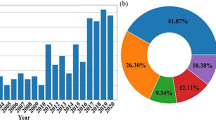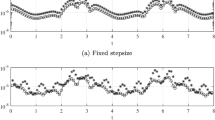Abstract
Using the limit point formula of the Loop subdivision scheme, we propose a very simple and efficient method for constructing interpolation surface of triangular meshes by Loop subdivision scheme. The excellent properties of the method are: (1) Locality: the perturbation of a given vertex only influences the surface shape near this vertex. (2) Efficiency: the locations of new points can be computed with explicit formulae. (3) Easiness in implementation: only the geometric rule of the first step should be modified. (4) Freedom: for each edge, there is one degree of freedom to adjust the shape of the interpolation surface. (5) Easiness in generalization: it is easy to generalize our method to other approximation subdivision schemes with explicit formulae to compute limit point.
Similar content being viewed by others
References
Li G. Construction of subdivision schemes and fitting techniques based on subdivision surfaces (in Chinese). Report of post-doctoral, Hangzhou: Zhejiang University, 2003
Catmull E, Clark J. Recursively generated B-spline surface on arbitrary topological meshes. Comput Aid Des, 1978, 10:350–355
Loop C. Smooth subdivision surfaces based on triangles. Master Thesis, Utah University, USA, 1987
Zorin D, Schröder P. Subdivision for modeling and animation. Course Notes of SIGGRAPH 2000. ACM SIGGRAPH, 2000
Dyn N, Levin D, Gregory J A. A butterfly subdivision scheme for surface interpolatory with tension control. ACM Trans Graph, 1 1990, 9:160–169
Zorin D, Schröder P, Sweldens W. Interpolating subdivision for meshes with arbitrary topology. Comput Graph, 1996, 30:189–192
Kobbelt L. Interpolatory subdivision on open quadrilateral nets with arbitrary topology. Comput Graph Forum, 1996, 15:409–420
Hoppe H, DeRose T, Duchamp M, et al. Piecewise smooth surface reconstruction. Comput Graph, 1994, 28:295–302
Nasri A. Polyhedral subdivision methods for free-form surfaces. ACM Trans Graph, 1987, 6:29–73
Brunet P. Including shape handles in recursive subdivision surfaces. Comput Aid Geometr Des, 1988, 5:41–50
Halstead M, Kass M, DeRose T. Efficient, fair interpolation using Catmull-Clark surface. Comput Graph, 1993, 27:35–44
Zheng J, Cai Y. Interpolation over arbitrary topology meshes using a two-phase subdivision scheme. IEEE Trans Visual Comput Graph, 2006, 12:301–310
Warren J, Weimer H. Subdivision Methods for Geometric Design: A Constructive Approach. San Francisco: Morgan Kaufmann Publishers, 2002
Ma W, Ma X, Tso S K, et al. A direct approach for subdivision surface fitting from a dense triangle mesh. Comput Aid Des, 2004, 36:525–536
Yang X. Surface interpolation of meshes by geometric subdivision. Comput Aid Des, 2005, 37:497–508
Author information
Authors and Affiliations
Corresponding author
Rights and permissions
About this article
Cite this article
Deng, C., Wang, G. Interpolating triangular meshes by Loop subdivision scheme. Sci. China Inf. Sci. 53, 1765–1773 (2010). https://doi.org/10.1007/s11432-010-4049-y
Received:
Accepted:
Published:
Issue Date:
DOI: https://doi.org/10.1007/s11432-010-4049-y




